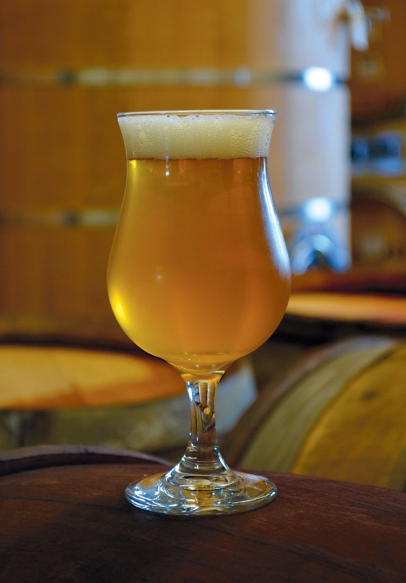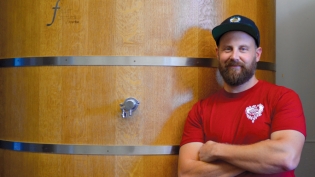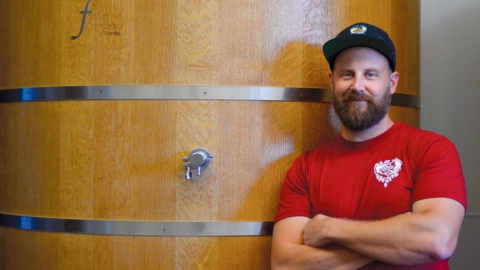Sour Beers - Pucker Up Your Mug
Seriously? Sour beer?
Jorge Alem, co-founder of the Ojai Beverage Company, suggested I give Monk’s Café Sour Flemish Ale a try. It’s tart, sour, refreshing, on the sweet side. I am instantly a fan.
Over the years since, I have sampled many “sours.” Have you tried one? You ought to. I believe people quickly decide after the first sip whether they like sour beers or not. Before you cross them off your list too soon, know that there’s a range of sourness depending on how long they’re aged, so if you don’t like one sour beer, try a younger one. It might not be as sour.
While sour beer is becoming trendy, beer actually has been sour for most of its history. Traditionally some beers—like Lambics—were fermented by leaving the wort (the unfermented syrupy mixture that turns into beer) out to cool in the open air, where it was inoculated by local microflora. Others soured after fermentation when they were placed in oak casks for storing or delivery to pubs or faraway lands. The barrels often contained microbes.
Brewers used hops, acidification and very high alcohol levels to preserve beer; they played with the hops levels and often blended these approaches for balanced results.
Natural yeasts reacted with the wort, causing fermentation. With developments in science and pasteurization during the 1800s, brewers could better control fermentation. A big step in modern brewing came from the insight that certain microorganisms were responsible for fermentation. Isolating specific strains led to the understanding we have of beers’ flavors.
If you are a boomer like me, your beer history has been the result of post-Prohibition beer. Before the turn of the 19th century, more than 4,000 breweries existed. With advancements in the industrial era of refrigeration, transportation and mass production, consolidation plummeted the number to fewer than 100 producers of the same bland lager style of beer. Heineken or Guinness was about as different as you could get.
The good news is times have changed. In 2014, 3,464 craft brewers operated in the U.S., according to the Brewers Association (BrewersAssociation.org).
It’s beervanna! It ain’t bland anymore.
Sour beer—category 17 of the 23 standardized categories of the BJCP (Beer Judge Certification Program)—is amazingly complex and varied. Fruit is often added to sour beer, including apricot, blueberry, cherry, kumquat or elderberry. Everything from super sweet and fruity to just a subtle whiff of sweetness or fruitiness. Aging in wooden barrels that had been previously used for bourbon, whiskey, rye or wine add another layer of complexity. Sometimes sour beers are blended—like wines are often blended—to create certain flavors.
Years after my first sip, I found myself in a jam-packed Monk’s Café in Philadelphia, one of the world’s great beer bars—put it on your list or at least check out its bottle list on the website—an education in itself. The Belgian list is huge, including beers from the famous Cantillon, a brewery that still uses open-air tubs allowing wild yeasts to ferment the wort.
Surf Brewery in Ventura not only brews excellent beer, but they are also the home of VIBE (Ventura Independent Beer Enthusiasts), Ventura’s (and my) brewing club. VIBE has become known for its sour beer poured at beer festivals; at the Southern California Home Brewers Festival in Temecula this year club president Andy Carter hosted the “Hour of Sour.”
Because a typical wooden barrel—from wineries or distilleries—holds about 55 gallons, several VIBE members can contribute as a group brew to fill a barrel. Then the scientists in the group can mess with adding the “bugs” (brewers’ slang for wild yeasts such as Brettanomyces, Lactobacillus and Pediococcus).
VIBE has one barrel of beer that started as a porter about six years ago. Each year we take some beer out and add some more fresh beer. The resulting sour ale is a constant work in process. This technique is called a “solera.” We have also brewed sour Lambics and Flanders ales.
So, yes, sour beer. Seriously.
SOUR BREWERS
There are a number of sour beer options produced near and far, and available at local specialty beer retailers and establishments. Here are some of my favorites.
Barrelhouse 101, Ventura (BarrelHouse101.com): Owner Joby Yobe keeps about five sours in his 101 taps.
Ojai Beverage Company, Ojai (OjaiBevCo.com): Jorge Alem usually has one or two sours in his 50 taps.
Surf Brewery, Ventura (SurfBrewery.com): The brewery has a sour Flanders Red Ale in their Scientific Series. It benefits from nearly three years of barrel aging in French oak and blending.
Casa Agria Specialty Ales, Oxnard (CasaAgria.com): The brewery will focus on mixed fermentation farmhouse-style ales and barrelaged wild varieties. (See Brewer’s-Eye View on facing page.)
The Bruery, Placentia (TheBruery.com): It brews barrel-aged beers. Not all are sours, but they have a wide variety of top-notch ales.
Firestone Walker Brewing Company–Barrelworks, Buellton (FirestoneBeer.com/Barrelworks): This is a must-see-and-taste in my book. They have a huge barrel facility where they make a variety of sours, stouts and aged ales.
Jolly Pumpkin Artisan Ales, Dexter, Michigan (JollyPumpkin.com): This Great Lakes-area brewer produces a fabulous selection of barrel-aged sours.
Cascade Brewing Barrel House, Portland, Oregon (CascadeBrewingBarrelHouse.com): They offer amazing barrel-aged beers using a variety of Oregon fruit.
“Based on our recent benchmarking survey, 37.9% of breweries report using Brettanomyces in fermentation, 34.8% report using Lactobacillus and 19.3% report using Pediococcus (the three strains most associated with “sours” in the U.S.). That isn’t a percentage of volume—since many breweries use those strains for only a small percent of production—but it does suggest a high percentage of breweries are experimenting with wild/sour styles.”
—Bart Watson, PhD, Chief Economist Brewers Association
Top Cities for “Sour Beer” Google Searches:
San Francisco San Diego Philadelphia Chicago Austin Los Angeles
Searches for “sour beer” increased sevenfold from September 2007 to September 2015 (projected).
—Google Trends
Otis Bradley is an Ojai custom homebuilder and home brewer. He’s a longtime member of VIBE, Ventura Independent Beer Enthusiasts.







